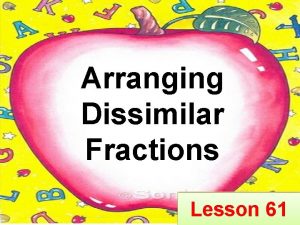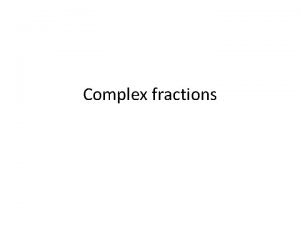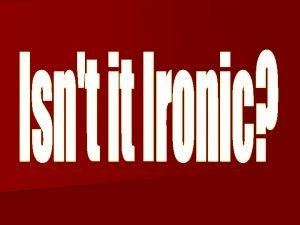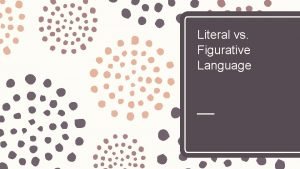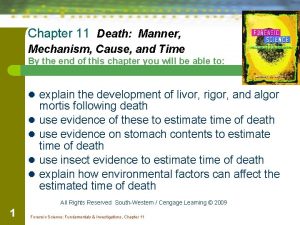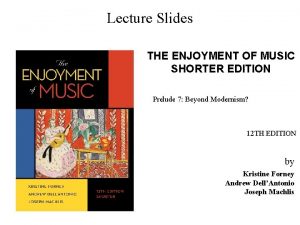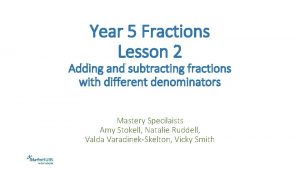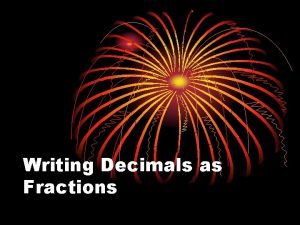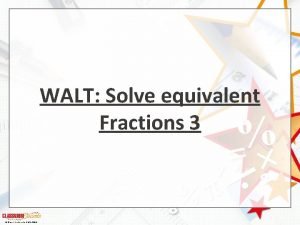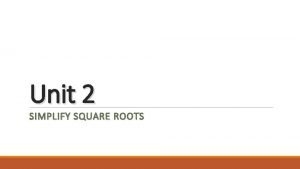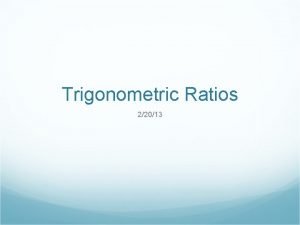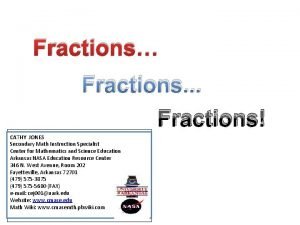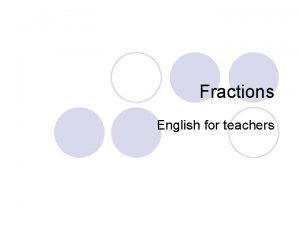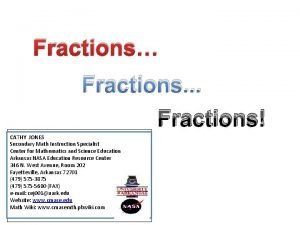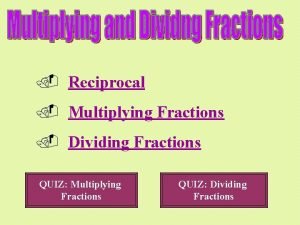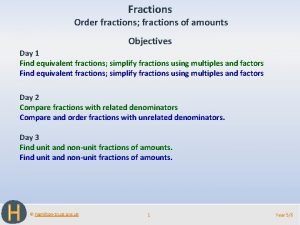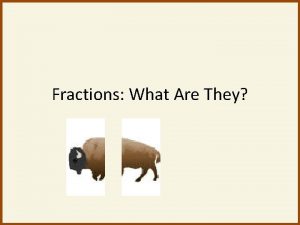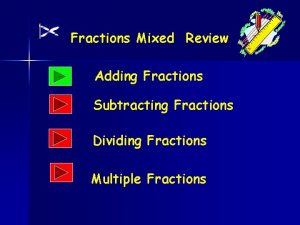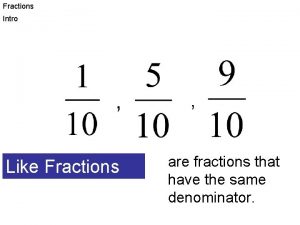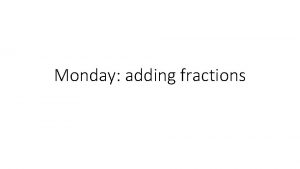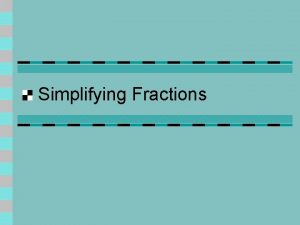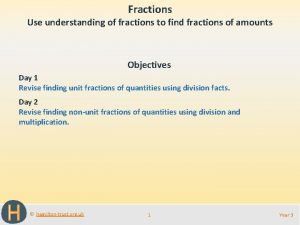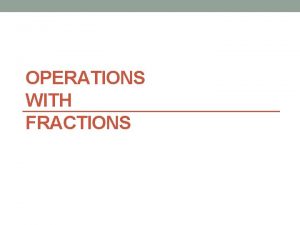Chapter 2 Fractions The Meaning of Fractions Fractions























































- Slides: 55

Chapter 2. Fractions • The Meaning of Fractions • Fractions as Numbers • Equivalent Fractions • Comparing Fractions • Percent

The meaning of fractions • A and B are whole numbers, and B is not zero • If an object is divided in B equal parts, then 1/B of the object is the amount formed by 1 part, and A/B of the object is the amount formed by A parts • If A/B is a fraction, then A is called the numerator and B is called the denominator • Numerator tells you how many parts • Denominator tells you how many of what type of parts

Numerator: the number of parts Denominator: the type or name of parts Fractions are defined in relation to a whole, and this whole can be one object or a collection of objects


What does equal parts mean?

Remarks • If one is asked to divide a shape like the one we saw in the previous slide, into equal parts; one might not know whether the parts should be equal in size (area) and shape or only they need to be the same size. • When stating a problem, make sure it is explicit enough for the students to understand. • In realistic situations, it is seldom a problem to determine what constitutes equal parts. In most cases, equal parts will be defined by dollar value, length, area, volume, or number.

What are Proper and Improper Fractions? is called a proper fraction if A and B are whole numbers, with B not zero, and A < B is called an improper fraction if A and B are whole numbers, with B not zero, and A ≥ B

Two ways of writing an improper fraction

Fractions as Numbers on the Number Line

Representing Improper Fractions on The Number Line How do you write the fraction represented by the following figure? What assumption did you make? The fraction can be written as :


Example: Plot 11/8 on the number line. • How many parts in do I divide the segment between 0 and 1? • Is 11/8 greater or less than 1? • How many 1/8 parts should I “copy” on the number line? • What would be the mixed number form of the fraction?

Example: Plot 11/8 on the number line. • How many parts in do I divide the segment between 0 and 1? • Is 11/8 greater or less than 1? • How many 1/8 parts should I “copy” on the number line? • What would be the mixed number form of the fraction?

Example: Plot 11/8 on the number line. • How many parts in do I divide the segment between 0 and 1? • Is 11/8 greater or less than 1? • How many 1/8 parts should I “copy” on the number line? • What would be the mixed number form of the fraction?

Decimal Representation of Fractions • Any rational number can be represented as a fraction, for example 2=2/1; 0. 5 = ½; 1. 3333… = 4/3; etc. • To represent a fraction A/B as a decimal number, we divide the numerator A by the denominator B

Can two different fractions represent the same number?

Equivalent Fractions In fact, every fraction is equal to infinite number of fractions!

Equivalent Fractions In fact, every fraction is equal to infinite number of fractions!

Equivalent Fractions In fact, every fraction is equal to infinite number of fractions! Example Why ¾ is equivalent with 15/20?

Equivalent Fractions In fact, every fraction is equal to infinite number of fractions! Example. Why ¾ is equivalent with 15/20? X 5

In general, if N is any counting number, and A/B is a fraction of a whole (any object or collections of objects), then: Another way to explain the equivalence relationship above is by multiplying any fraction A/B with 1 in the form N/N, where N is any counting number.

To summarize:

Common Denominators When we work with fractions simultaneously, it is desirable to have common denominators (same denominators)

Example

Example. Write 3/8 and 5/6 with common denominators in three different ways. First Way Calculate the common denominator by multiplying the individual denominators: Then, create equivalent fractions for both given rational numbers:

Second Way Find the smallest number divisible by both 6 and 8. We will call this the lowest common denominator (multiple).

Second Way Find the smallest number divisible by both 6 and 8. We will call this the lowest common denominator (multiple). That number is 24 Then, create equivalent fractions for both given ones:

Third Way Find any number divisible by both 6 and 8 (no matter how loarge) It can be done by multiplying the lowest common denominator by any counting number. For example: Then, create equivalent fractions for both given ones

The Simplest Form of a Fraction A fraction of whole numbers A/B (where B is not zero) is said to be in the simplest form (or lower terms) if there is no whole number other than 1 that divides both A and B evenly. In general:

Example Put the fraction 18/24 in lowest terms (or simplest form):

Alternatively, since 18 and 24 are both even numbers, we can divide both of them by 2: But 9/12 is not in lowest terms since there is 3 that divides both:

The best way: Find the largest number that divides both 18 and 24 (also called the greatest common divisor (factor)). This number for 18 and 24 is 6 since:

Comparing Fractions There are four standard ways of comparing fractions: 1. Converting into decimals 2. Using common denominators 3. Comparing fractions that have common numerator 4. Cross-multiplication

1. Comparing Fractions by Converting to Decimals Recall that we can convert any fraction A/B into a decimal number by simply dividing A to B. Example:

2. Compare Fractions by Using Common Denominators If two fractions have the same denominator, then the one with the greater numerator is greater Example:


3. Comparing Fractions that have Common Numerators. Fractions with the same numerator and increasing denominators become smaller:

Examples


4. Comparing Fractions by Cross-Multiplying. Note: denominators are assumed to be positive, i. e. B>0 and D>0

Example > = > > = =

Percent The word percent, which is usually represented by the symbol %, means “out of a hundred”.

Percent The word percent, which is usually represented by the symbol %, means “out of a hundred”. Percent, Fractions, and Pictures


Solving Percent Problems Three quantities: whole amount, portion, percent There are three types of percent problems: I) Finding the portion when the percent and the whole amount are known II) Finding the percent when the whole amount and the portion are known III) Finding the whole amount when the percent and the portion are known

Solving Percent Problems Ways to solve the percent problems: • Using Algebra • Using Percent Tables • Making Equivalent Fractions

I) Finding the Portion When the Percent and the Whole Amount Are Known: Susie must pay 6% tax on her purchase of $44. 00. How much tax must Susie pay?

Using a percent table to solve the problem: Percent Amount 100% $44 1% 6% $44 100= $0. 44 6 x $0. 44= $2. 64

Using equivalent fractions:

II) Finding the Percent When the Whole Amount and the Portion Are known. Nellie leaves a $9 tip for a meal that costs $50. What percent was Nellie’s tip? Algebraic Solution:

Using equivalent fractions: X 2

Using a percent table to solve the problem: What percent is 9 of 50? Percent 100% 50 = 2% 2% x 9 = 18% Portion (Amount) $50 $1 $9

III) Finding the Whole Amount when the Percent P and the Portion Are Known. A store gave $ 15 000 to schools in the community. This $ 15 000 represents 3% of the store’s annual profit. What is the store’s annual profit? Algebraic Solution:

Using equivalent fractions: X 5000

Using a percent table to solve the problem: Percent 3% 1% 100% Portion (Amount) $ 15 000 3 = $ 5 000 $ 5000 x 100 = 500 000
 Hát kết hợp bộ gõ cơ thể
Hát kết hợp bộ gõ cơ thể Frameset trong html5
Frameset trong html5 Bổ thể
Bổ thể Tỉ lệ cơ thể trẻ em
Tỉ lệ cơ thể trẻ em Voi kéo gỗ như thế nào
Voi kéo gỗ như thế nào Thang điểm glasgow
Thang điểm glasgow Chúa yêu trần thế alleluia
Chúa yêu trần thế alleluia Các môn thể thao bắt đầu bằng từ đua
Các môn thể thao bắt đầu bằng từ đua Thế nào là hệ số cao nhất
Thế nào là hệ số cao nhất Các châu lục và đại dương trên thế giới
Các châu lục và đại dương trên thế giới Công của trọng lực
Công của trọng lực Trời xanh đây là của chúng ta thể thơ
Trời xanh đây là của chúng ta thể thơ Mật thư anh em như thể tay chân
Mật thư anh em như thể tay chân 101012 bằng
101012 bằng độ dài liên kết
độ dài liên kết Các châu lục và đại dương trên thế giới
Các châu lục và đại dương trên thế giới Thơ thất ngôn tứ tuyệt đường luật
Thơ thất ngôn tứ tuyệt đường luật Quá trình desamine hóa có thể tạo ra
Quá trình desamine hóa có thể tạo ra Một số thể thơ truyền thống
Một số thể thơ truyền thống Cái miệng nó xinh thế chỉ nói điều hay thôi
Cái miệng nó xinh thế chỉ nói điều hay thôi Vẽ hình chiếu vuông góc của vật thể sau
Vẽ hình chiếu vuông góc của vật thể sau Thế nào là sự mỏi cơ
Thế nào là sự mỏi cơ đặc điểm cơ thể của người tối cổ
đặc điểm cơ thể của người tối cổ Ví dụ giọng cùng tên
Ví dụ giọng cùng tên Vẽ hình chiếu đứng bằng cạnh của vật thể
Vẽ hình chiếu đứng bằng cạnh của vật thể Phối cảnh
Phối cảnh Thẻ vin
Thẻ vin đại từ thay thế
đại từ thay thế điện thế nghỉ
điện thế nghỉ Tư thế ngồi viết
Tư thế ngồi viết Diễn thế sinh thái là
Diễn thế sinh thái là Dạng đột biến một nhiễm là
Dạng đột biến một nhiễm là Số.nguyên tố
Số.nguyên tố Tư thế ngồi viết
Tư thế ngồi viết Lời thề hippocrates
Lời thề hippocrates Thiếu nhi thế giới liên hoan
Thiếu nhi thế giới liên hoan ưu thế lai là gì
ưu thế lai là gì Hổ sinh sản vào mùa nào
Hổ sinh sản vào mùa nào Sự nuôi và dạy con của hươu
Sự nuôi và dạy con của hươu Sơ đồ cơ thể người
Sơ đồ cơ thể người Từ ngữ thể hiện lòng nhân hậu
Từ ngữ thể hiện lòng nhân hậu Thế nào là mạng điện lắp đặt kiểu nổi
Thế nào là mạng điện lắp đặt kiểu nổi Ang tuldok (dot) ay kumakatawan sa anong geometric figure?
Ang tuldok (dot) ay kumakatawan sa anong geometric figure? Simplifying complex fractions
Simplifying complex fractions Lexical and grammatical meaning in semantics
Lexical and grammatical meaning in semantics Literal and implied meaning
Literal and implied meaning Literal meaning vs figurative meaning
Literal meaning vs figurative meaning Conceptual meaning and associative meaning examples
Conceptual meaning and associative meaning examples Chapter 11 death meaning manner mechanism cause and time
Chapter 11 death meaning manner mechanism cause and time Chapter 67 neo romantic evocations
Chapter 67 neo romantic evocations Lesson 2 add like fractions
Lesson 2 add like fractions 99/100 as a fraction in simplest form
99/100 as a fraction in simplest form Adding and subtracting fractions with variables
Adding and subtracting fractions with variables Equivalent fraction 1/5
Equivalent fraction 1/5 Dmca square root
Dmca square root Ratios of trigonometry
Ratios of trigonometry










































